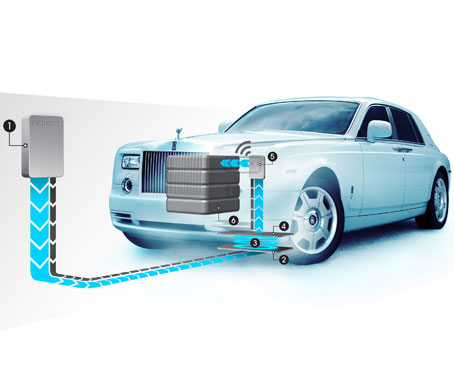Electric cars could become standard with the help of this new technology from HaloIPT, writes Sam Eichblatt.
July 26th, 2011
Tech company HaloIPT is investing in the long-term adoption of electric vehicles over standard cars by creating lighter, smaller and faster charging technology — which it hopes to eventually roll out across highways, city streets and parking lots across the world.
The technology — Inductive Power Transfer — was initially developed in an Auckland University laboratory, and allows vehicles to charge while parking or driving over a doormat-sized plate in the ground.

1 Power Supply 2 Transmitter Pad 3 Wireless Electricity & Data Transfer 4 Receiver Pad 5 System Controller 6 Battery
It aims to replace the battery and charger units currently in use for private electric cars, which take around 7 hours plugged into a 15-amp socket for a full charge.
“At the moment the cars are a bit heavy,” says Halo’s chief executive, Dr Anthony Thomson. “There’s no reason for that, except for the massive battery. It’s like carrying 10 lunches around with you every day, when you only need a little energy at a time. The energy can stay in the grid, and you can tap into as needed.”

The company differentiates itself from competitors by offering a smaller unit with more power density.
“It’s helping us in our hunt for new business,” says Thomson. “If we can say it’s the size of a laptop rather than a picnic table, that’s a lot of difference in terms of weight and size.”

So far, HaloIPT has worked with companies including Rolls Royce to create the ultimate sustainable, silent Phantom, and UK firm Drayson Racing, to develop an all-electric prototype race car.
It also recently announced plans to partner with Chargemaster PLC on a scheme to develop a nationwide electrical vehicle-charging network for the UK by the end of 2012.
HaloIPT
haloipt.com
INDESIGN is on instagram
Follow @indesignlive
A searchable and comprehensive guide for specifying leading products and their suppliers
Keep up to date with the latest and greatest from our industry BFF's!

London-based design duo Raw Edges have joined forces with Established & Sons and Tongue & Groove to introduce Wall to Wall – a hand-stained, “living collection” that transforms parquet flooring into a canvas of colour, pattern, and possibility.

The undeniable thread connecting Herman Miller and Knoll’s design legacies across the decades now finds its profound physical embodiment at MillerKnoll’s new Design Yard Archives.

Established in 1983, Ricky Richards delivers design excellence through premium, high-quality textiles – and Ferroshade by Ricky Richards does no less.

To mark a full decade in practice, Cera Stribley co-founders Domenic Cerantonio and Chris Stribley share their thoughts on what the future might hold.
The internet never sleeps! Here's the stuff you might have missed

The luxury vinyl plank collection from Godfrey Hirst includes three distinctive palettes – Olympus Neo, Olympus Parquet and Olympus Stone.

The American Hardwood Export Council (AHEC) has collaborated with leading Indonesian designer Hendro Hadinata on the KARANA Collection, unveiled at Indonesia Design Week (IDW).

The shared Melbourne office brings together Studio 103 and McCormack in a dual headquarter that doubles as a showcase of materials and craft.

Annabelle Smith has been named winner of The Graduate at the INDE.Awards 2025, in partnership with Colorbond. Her visionary project reimagines housing in Aotearoa, proposing a modular and culturally responsive model uniting people, architecture and nature.